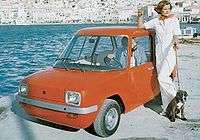Enfield 8000
The Enfield 8000 is a two-seater battery-electric city car, introduced in 1973 and developed in the United Kingdom by Isle of Wight company Enfield Automotive, owned by Greek millionaire Giannis Goulandris. The car was designed by a group of Greek and British engineers headed by Constantine Adraktas (Chairman and Managing Technical Director of Enfield) and production, immediately after its introduction, was moved to the Greek island of Syros.[1][2] 120 cars were built in total, of which 65 were used by the Electricity Council and electricity boards in the south of England.
Powered by an 8 bhp (6 kW) electric motor and lead-acid batteries, the car has a top speed of around 48 mph (77 km/h) and a range of around 40 miles (64 km). In Autocar's test in 1975 they found it had a usable range of 25 miles (40 km).[3] It could accelerate from 0 to 10 mph (16 km/h) in 1.6 seconds, 20 mph (32 km/h) in 4.7 seconds and 30 mph (48 km/h) in 15.7 seconds. Brakes are by drums front and back.
It has a ladder-type square section tube chassis frame with aluminium alloy body panels stretched over steel frames.[3] It uses suspension parts from the Hillman Imp, doors were adapted from the Mini and a rear axle derived from Reliant three-wheelers.
Neorion

The company had been incorporated into the Greek Neorion company, also owned by Goulandris, and production was transferred to Syros, the company having transformed into a new Greek company, Enfield-Neorion, headquartered in Piraeus. There have been many arguments regarding the reason why Mr. Goulandris decided to produce the car in Greece, including conspiracy theories. Thanos Lebesis, then General Manager of Enfield-Neorion, argues that Mr. Goulandris had thought that "the company was owned by Greeks, the car was designed by Greeks, so it should also be produced by Greeks".[2] However, it could not be legally sold in Greece due to tax categorization issues connected with electric power, so production was exported to the United Kingdom.[2] Enfield-Neorion developments included a "Jeep" version aiming at the rent-a-car market in the Greek islands, but none could be sold locally.
Flux Capacitor
A highly customised version called 'Jonny's Flux Capacitor' built by Jonny Smith is street legal.[4][5] As of July 2016, the 'Flux Capacitor' is the world's fastest street legal electric vehicle.[6]
References
- "Άλλο ένα Enfield 8000 γύρισε πίσω στην Ελλάδα (one more Enfield 8000 returns to Greece)". Syros Agenda. 20 April 2017. Retrieved 21 June 2017.
- Stavropoulos, Michalis (2014). "Ανάμεσα σε δύο νησιά (A Tale of Two Isles) Documentary about the Enfield Electric Car".
- "Test Extra: Enfield 8000 Electric". Autocar. 144 (4137): 66–69. 21 February 1976.
- Smith, Jonny. "Flux Capacitor - Europe's fastest street-legal electric car". UK. Retrieved 20 July 2016.
- Gitlin, Jonathan M. (15 December 2015). "On the road in the Flux Capacitor, Europe's fastest street-legal EV". Ars Technica. US. Retrieved 20 July 2016.
- Gitlin, Jonathan M. (20 July 2016). "The Flux Capacitor is now the world's fastest street-legal electric car". Ars Technica. US. Retrieved 20 July 2016.
External links
![]()
- Video of an Enfield 8000 ECC with modern electronics
- A Tale of Two Isles (2014) Documentary https://www.imdb.com/title/tt3838966/